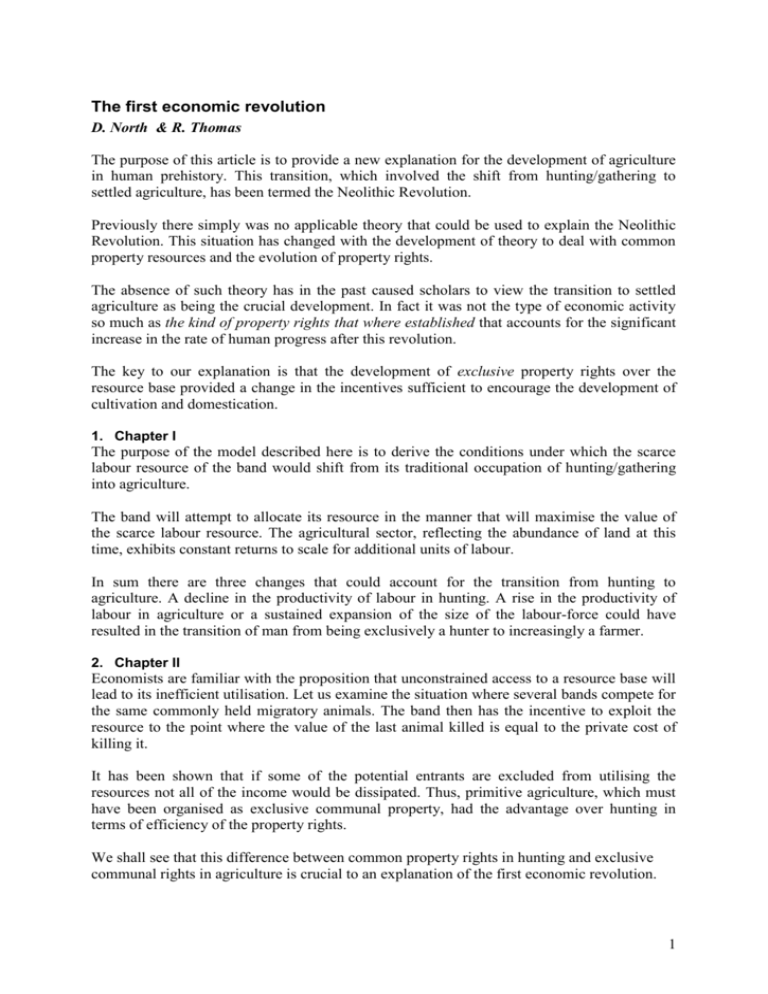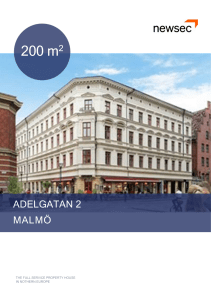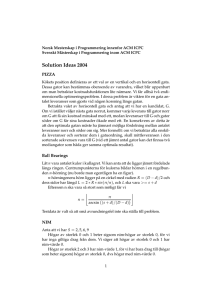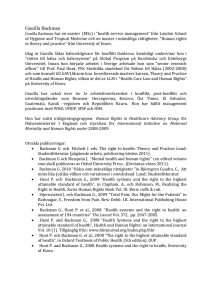The first economic revolution
advertisement

The first economic revolution D. North & R. Thomas The purpose of this article is to provide a new explanation for the development of agriculture in human prehistory. This transition, which involved the shift from hunting/gathering to settled agriculture, has been termed the Neolithic Revolution. Previously there simply was no applicable theory that could be used to explain the Neolithic Revolution. This situation has changed with the development of theory to deal with common property resources and the evolution of property rights. The absence of such theory has in the past caused scholars to view the transition to settled agriculture as being the crucial development. In fact it was not the type of economic activity so much as the kind of property rights that where established that accounts for the significant increase in the rate of human progress after this revolution. The key to our explanation is that the development of exclusive property rights over the resource base provided a change in the incentives sufficient to encourage the development of cultivation and domestication. 1. Chapter I The purpose of the model described here is to derive the conditions under which the scarce labour resource of the band would shift from its traditional occupation of hunting/gathering into agriculture. The band will attempt to allocate its resource in the manner that will maximise the value of the scarce labour resource. The agricultural sector, reflecting the abundance of land at this time, exhibits constant returns to scale for additional units of labour. In sum there are three changes that could account for the transition from hunting to agriculture. A decline in the productivity of labour in hunting. A rise in the productivity of labour in agriculture or a sustained expansion of the size of the labour-force could have resulted in the transition of man from being exclusively a hunter to increasingly a farmer. 2. Chapter II Economists are familiar with the proposition that unconstrained access to a resource base will lead to its inefficient utilisation. Let us examine the situation where several bands compete for the same commonly held migratory animals. The band then has the incentive to exploit the resource to the point where the value of the last animal killed is equal to the private cost of killing it. It has been shown that if some of the potential entrants are excluded from utilising the resources not all of the income would be dissipated. Thus, primitive agriculture, which must have been organised as exclusive communal property, had the advantage over hunting in terms of efficiency of the property rights. We shall see that this difference between common property rights in hunting and exclusive communal rights in agriculture is crucial to an explanation of the first economic revolution. 1 3. Chapter III It is clear that the number of people has increased through time but not either continuously or at a constant rate. So long as the standard of life was above a certain level there was a tendency for man to increase in numbers. In the world of prehistoric man those bands that attempted to adjust their population to the size of the local resource base would eventually lose out to those bands that encouraged large and increasing populations, even if it meant migration and the subdivision of the band. 4. Chapter IV In terms of our model this was a world of constant returns to an increasing labour force, so that growth in population resulted in a proportionate increase in output. This world of constant returns persisted as long as there was empty land of equal productivity for a growing population to exploit. As population pressure continued to grow and compete for these common property resources they would become increasingly scarce and relatively more “costly” in labour time to gather. The solution to the common property dilemma was the development of exclusive communal property rights. Once exclusivity was established, innovation within agriculture would gradually develop in a trial-and-error process. Under the exclusive property rights such innovation would be encouraged by raised returns. This was a revolution because the transition created an incentive change for mankind of fundamental proportions. The incentive change stems from the different property rights under the two systems. When common property rights over resources exist, there is little incentive for the acquisition of superior technology and learning. In contrast, exclusive property rights which reward the owners provide a direct incentive to improve efficiency and productivity, or, in more fundamental terms, to acquire more knowledge and new techniques. It is this change in incentive that explains the rapid progress made by mankind in the last 10 000 years in contrast to his slow development during the long era as a primitive hunter/gatherer. 5. Swedish Summary Syftet med artikeln är att förklara utvecklingen av jordbruk bland de förhistoriska människorna. Det fanns innan artikeln ingen tillämplig teori som kunde förklara jordbrukets införande. Artikeln tittar dels på en enkel statisk modell som stipulerar de förutsättningar som krävs för en överföring av arbetskraft från jakt till jordbruk. Därpå lägger författarna fram en egen modell som inkorporerar hur egendomsrättigheter och befolkningstillväxt påverkar människans beteende. Den statiska modellen Människan ägnar sig enbart åt jakt om marginalnyttan med jakt när all arbetskraft används är högre än marginalnyttan med en enhet arbetskraft använt i jordbruk. 2 Om populationen stiger är det troligt att marginalnyttan med ytterligare personer involverade i jakt sjunker. Vid en viss punkt blir det rationellt att några personer då börjar ägna sig åt jordbruk. Den nya modellen Utvecklingen av exklusiva tillgångsrättigheter hindrade utomstående från att skörda resurserna och även regler som begränsade hur intensivt de närstående utnyttjade resurserna. Vid någon punkt var det rationellt för ett ”band” att hitta en bördig plats, slå sig ner på denna, och med tvång hålla utomstående borta. Övergången skedde som ett resultat av ett ökande befolkningstryck under en lång tidsperiod. De exklusiva tillgångsrättigheterna skapade incitament för ägarna att öka effektiviteten och produktiviteten genom att öka kunskapen och utveckla tekniken. 3



